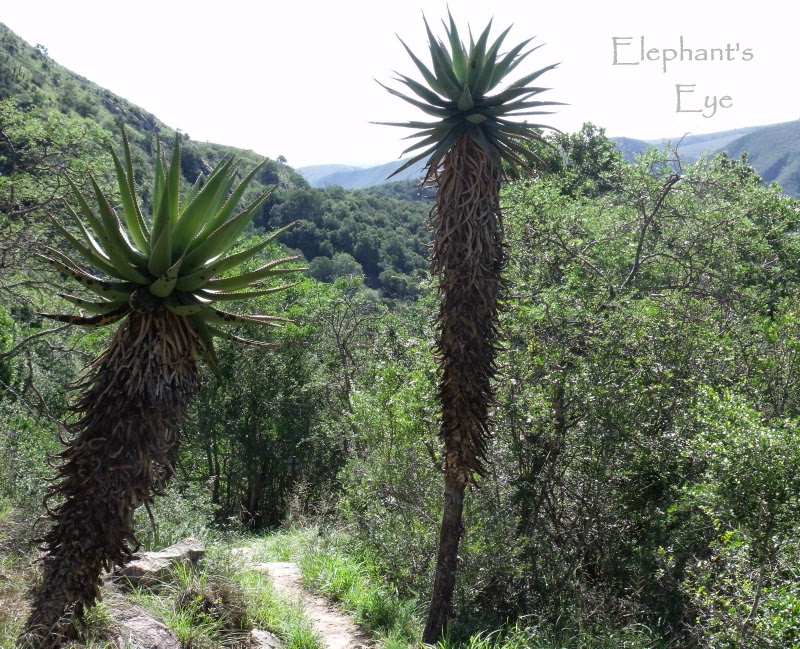Cycad Trail in the Zuurberg
by Diana Studer
- gardening for biodiversity
in Cape Town, South Africa
The Ungardener is a game-watcher - warthogs, elephants and vervet monkeys at Addo. I prefer to walk, look at birds, and flowers. Tourists are allowed on hiking trails in national parks, but only where there are no lions about.
Addo has 5 of South Africa’s 7 biomes. Spekboom forms the Sub-tropical thicket. In the Zuurberg we have an overlap from the Nama Karoo. Expecting fynbos, but we find huge aloes.
 |
| Aloes at Zuurberg |
We walked in the Zuurberg mountains in March 2010. Pristine landscape rolling away into the distance. The heart and mind and soul expand - to breathe. No city crowds claustrophobia. Grassland, fynbos and forest. Used to mountain landmarks, I find the rolling hills, disconcerting.
 |
| Zuurberg in Addo |
If cycads are unfamiliar to you, you may see a tree-fern here (or a rather vicious palm-tree). But think tree-fern with an Agave Attitude and Teeth on the huge leaves. At the Kirstenbosch Indigenous Plant Sale I heard two cycad volunteers commiserating with each other. ‘I’m wearing a leather jacket AND an overall and they still attacked me!’ Plant collectors love Cycads, the rarer the better. And those with lots of money, will pay those struggling to survive, to poach plants from the wild. We saw only a handful of cycads on this walk. In desperation the powers that be, have taken to microchipping large plants to protect them.
 |
| Cycad at Zuurberg |
From PlantZAfrica - Encephalartos longifolius was found by Swedish botanist Carl Peter Thunberg and Francis Masson in 1772 during a trip to the Eastern Cape. This cycad can grow 4.5m. Classified under Appendix 1 of the CITES Convention, threatened with extinction. This species grows in acid sand with fynbos, or in grassland, or in succulent thicket. Encephalartos is only found in Africa. The seeds are especially toxic. During the Anglo-Boer War General Jan Smuts and his commando were besieged by British troops in the Zuurberg. With no food, some men tried cycad seeds. They were in agony as the poison took effect, but most had recovered by morning. Baboons, hornbills and small rodents do feed on the flesh covering the seeds. The plants grow slowly, which provokes poaching, but small plants are available from nurseries. Will grow in containers. In temperate or cool sub-tropical climates. (This species is the only cycad found growing in fynbos)
Up in the mountains we find fynbos (similar to Californian chaparral). Just this one pincushion protea in flower in March 2010.
 |
| Zuurberg pincushion protea |
A huge variety of bulbs. We saw only a Watsonia.
 |
| Watsonia at Zuurberg |
The trail winds around the crest. First the open grassland and aloes. Then down into the kloof (valley) to the cycads. We continued thru the forest, and the grateful shade, it was hot when we started. We found the Watsonia and this straw flower, everlasting. Sparkling like silver in the deep shade.
 |
| strawflower or everlasting at Zuurberg |
Hike back up thru the sun, to the car. Discover, to my wonder that this part of the country is where half my garden comes from. Elephant country! Tecoma, in the standard orange. Plumbago growing wild by the road, scattered with a sprinkling of sky blue flowers, THIS is where your Plumbago comes from.
In April 2010 Susan J. Tweit commented - I think of cycads as so tropical, not a chaparral plant--now I know better. And to link the wild habitat with our common garden friends enriches our understanding of the ecological roots of our gardens.
In April 2010 Susan J. Tweit commented - I think of cycads as so tropical, not a chaparral plant--now I know better. And to link the wild habitat with our common garden friends enriches our understanding of the ecological roots of our gardens.
Pictures by Jurg and Diana Studer
of Elephant's Eye on False Bay
(If you mouse over teal blue text, it turns seaweed red.
Those are my links.
To read or leave comments,
either click the word Comments below,
or click this post's title)

such amazing plants, and to think people have gone to such lengths to protect them by micro chipping, thats wonderful, the flowers are incredible, to walk on ground where lions walk, it is incredible, amazing, I wish I could smell this beautiful area, it must be intoxicating, the air filled with such beauty,
ReplyDeleteHad a friend walking thru our garden and she said it smells so wonderful! You stroke the leaves and walk away with perfumed hands.
DeleteHi Diana, thanks for the lovely journey through South Africa's flora. I wish poachers and those with "lots of money" would let those plants grow in peace.
ReplyDeleteTo me the cycad tree will remain the palm-tree with teeth on its leaves ;-)
We sadly left 2 in our Camps Bay garden. Too big to dig up. No space in the False Bay garden, they need to be at a respectful distance!
DeleteWonderfull landscape in ZA, best regard from Belgium
ReplyDeletesuch a rugged, lovely walk especially without the lions!
ReplyDeleteA beautiful place right on my doorstep. I haven't walked in the Zuurberg but I have gone horse riding in that section of the park last year. A beautiful area
ReplyDeleteThanks for sharing this wonderful place Diana, you make me want to visit.
ReplyDelete